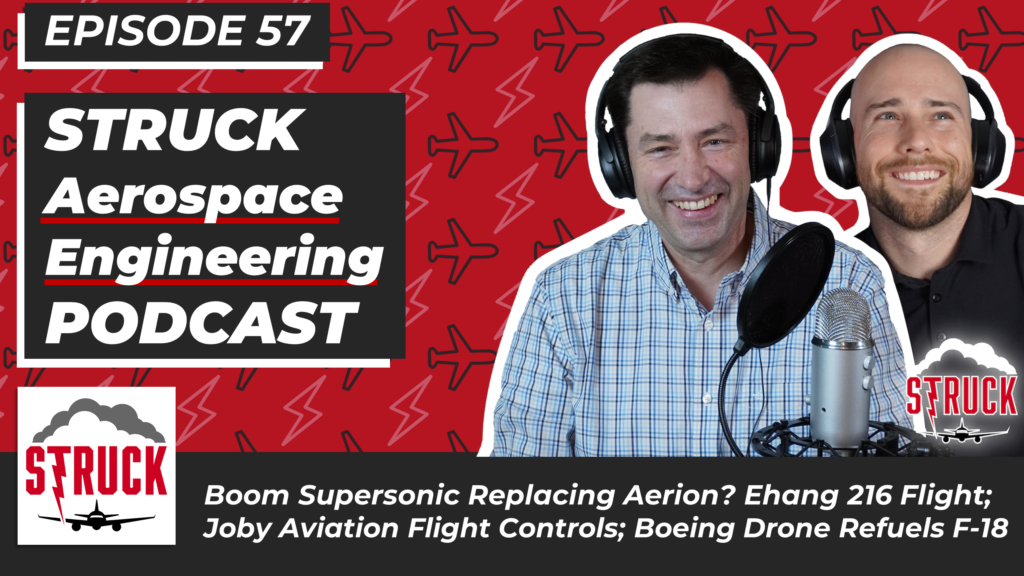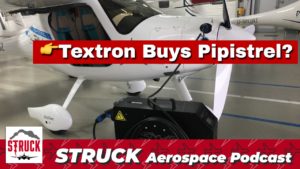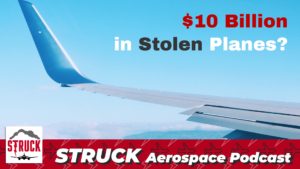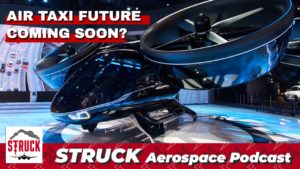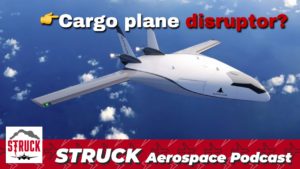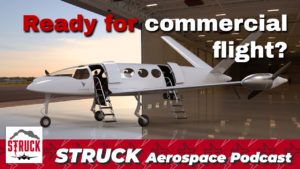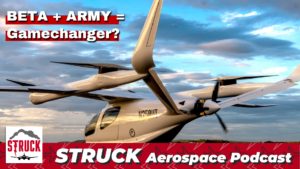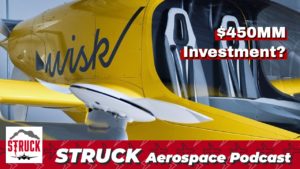Will the Boom Overture supersonic jet take off now that United Airlines has placed a future order? Can Boom succeed where Aerion recently failed? The Boeing MQ-25 drone recently refueled an F-18, a first in aviation. Plus, the Ehang 216 takes flight and Joby announces their new, simple flight controls: are they are a game-changer?
Learn more about Weather Guard StrikeTape segmented lightning diverters and aircraft lightning protection consulting services. Follow the show on YouTube, Twitter, Linkedin and visit us on the web. Have a question we can answer on the show? Email us!
Podcast: Play in new window | Download
Transcript – EP57 Boom Supersonic, Boeing MQ-25 Refueling Drone Plus Ehang & Joby EVTOL News
0:00
This episode is brought to you by Weather Guard Lightning Tech at Weather Guard. We support design engineers and make lightning protection easy.
0:14
You’re listening to the struck podcast. I’m Dan Blewett. I’m Allen Hall. And here on strike we talk about everything aviation, aerospace engineering and lightning protection.
0:30
Alright, welcome back to the struck podcast. I’m your co host, Dan Blewett. On today’s show, we’re going to talk about a new contract between bombard a Learjet and the US Air Force looks like it’s worth about almost half a billion dollars, so exciting for them. We’ll talk a little bit about more about supersonic jets. So obviously aireon collapse, we’ll talk a little bit more about that. There’s been some interesting news stories that have come out. And then we’ll also talk about boom, announcing a partnership with United united wants to buy a bunch of planes. So we’ll see if that comes to fruition. Obviously, that’s going to be quite a long game. In our engineering segment, we’ll talk about a Boeing mq 25 drone, refueling and FA t fa 18 in flight. So pretty exciting. First time a drone has refueled manned aircraft. And we’ll also talk a little bit about airships, and why one maker is betting that passengers will choose comfort over speed. Lastly, in our E VTOL segment, we’ll talk about ehang. And some interesting news about flight controls from Joby. So, let’s start with mrda. They’ve got a $464.8 million contract for bombarding a global 6000 aircraft with their Air Force. what’s notable about this aircraft, it’s just a thing of it as a midsize business jet, which makes the tube section
1:54
decently sized. So you can put some humans in it and put equipment in it. So if you’re running a special missions aircraft, where you want to put a couple of control centers, in it, monitoring stations, those kind of things, you can, you can fit that all that infrastructure into the aircraft, you have room to do it, there’s places to mount all that hardware. And then typically what those aircraft will have is sensors mounted on the top of the aircraft on the fuselage and on the belly to look left or right, up and down and communicate satellite data back to whoever they want to send it to. So there’s a you just need a certain amount of size aircraft to do all that and the global 6000 is sort of is really a nice platform for that and that’s they’ve been doing a lot of work in Wichita Learjet, they’re on modding and doing military support aircraft for a long time. I mean, I think I can revert back into the early 2000s. They were doing some back then I worked on a couple of those. And I think the the bonus here is that Wichita as a city has been really getting hammered on terms of not having any really new projects going on. Textron has got a couple of derivative projects going on. But in terms of Lear, Jet Lear jets been shrinking and they shut down all production of Lear jet just recently so everybody is left at Lear jet on the west side of town there needs something to work on. And so it’s good they earn you know, 400 $500 million project gets some a couple years out in terms of support, and they have a great flight test. And they’ve always had a great Flight Test Center in Wichita. So all the Bombardier flight test programs, even though the aircraft may be built up in Canada, typically it gets shipped down to Kansas to do all the flight tests, the flight test pilots, all the people that support flight test, the technicians and mechanics, all the specialist engineers that are doing all the all the data monitoring and that sort of thing are all located in Wichita. So there is a like there’s little expertise center in Wichita and the military mods are done in Wichita too. So it has this certain niche of expertise and they’ve been a little bit struggling so this $500 million dollar contracts going to get them going again which is good for the city because it’s which was always the center of small aircraft forever and it seemed to lose its luster a lot of as we seen on some of the V tall stuff. It’s all these most went to California.
4:29
So it’s moving out of Wichita, which is sad
4:34
because which was a lot of good engineers, a lot of good mechanics and technicians are all there everybody’s there but these new programs are starting to do you think it’ll completely rebound as a as the hub mode that it once was or, you know, seen its best days but can maybe you still you know, recover and stay here’s what’s driving the California bit and also beta up in Vermont, not far from us is available.
5:00
of cash, it has to do with the investors located there locating these companies where the investors are, and a case of beta, the investors are Vermont based or New Hampshire based. In some cases, there’s a couple of different investors there. In the case of like a Joby or an archer and those kinds of companies, this all the Silicon Valley, cash or Google cash investment groups that are there. So there are no moving aircraft companies. So where are the investors are and that didn’t used to be the case. It used to be
5:31
investors would come to you because you had the infrastructure. That’s, that’s all gone away. It’s crazy. Think about Yeah, which which it makes sense. Like, you know, you hear stories, like if you want to be a writer, like find a place where there’s a strong community of writers, so you can bounce ideas off each other, you can be around each other, you can be pushed by one another. So I get that, it seems like you know, the world so connected, that it wouldn’t matter where your company is, but you know, when you’re down the street, and you can pitch an investor who’s really busy, and he says, Yeah, I got, I got 20 minutes, like, stop by this restaurant be here, you know, 140. And if you’re in town, you can do that. And if you’re in Wichita, and you’ve got to jump on a plane, you know, that’s not that’s not a direct flight. I mean, that makes sense, which ties in a weird spot is not a lot of direct flights. So which toy is going to go through Denver or Dallas to get there, so it’s not an easy city to get in and out of, and they’ve been working on that for forever to try to get more direct flights to Wichita, which would I think open it up but the other part of Wichita which is really strange right now, so you know, spirits spirits there. And they make a lot of parts for air Airbus and Boeing aircraft and their their big company, that kind of what was Boeing at one point kind of move to spirit? Not so much in people, but in terms of company format, what it does, yeah. But that they started a kind of a collaborative situation with Wichita State, who, you know, probably 20 years ago, called NIH, our National Institute of aviation research, if I remember the acronym correctly, which was supposed to be that incubator for aviation companies and and and to support the local aviation companies have given them an advantage,
7:09
on a technical side, on a testing side on a technology side, and it hasn’t seemed to come to fruition, in the sense of all the great work that nyer has done is being sucked up by these companies that are not in Kansas. They’re all using that data that nyer provides for free. And then here is funded. Wait, are you saying? Are you saying they’re not in Kansas anymore? Yeah, I mean, sort of. So the data all the all the all the if you think about composites technology, and all the all the little bits and pieces, I don’t get too technical about composites. But there’s a lot of data you need to know about how composite and an epoxy system work together, hot, cold, wet performance data. Now, our does all that, and that data gets publicized in the FAA and the federal government and state of Kansas in some part fund that. And then companies anywhere in the country can use that data, which is awesome, because it stops sort of the repetitive testing, and all these small companies have to do, it’s a lot of overhead expense that you don’t have to pay for anymore, because you’ve got this commerce repository for that data. The problem is, is the common repository of data that no one has paid for. So I don’t have to be in Kansas to tap that. Tap that resource like me in California, or I can be in Vermont, which is what they’re doing or it can be in Minnesota, like Sarah says, or whoever dimond up in Canada, and it doesn’t drive those small airplane companies to be in state. So I wonder if they had a chance to rethink that whether they would do the same thing? I would say probably not. And the state of Kansas is probably very disappointed in not so much nyari I don’t think they’re disappointed necessarily in hierarchy. I think it’s a lot of good things. I think what they’re disappointed in that’s not driving the traffic and the businesses like they thought it would. That’s the that’s the that’s the pinch point. And I can’t imagine that hasn’t come up. I haven’t seen a lot. I haven’t seen a lot of articles about that yet. But that’s got to come up at some point. Because there’s billions of dollars being invested in Joby Archer, whisk beta, you name them it’s gotta be
9:16
you start counting up there’s gonna be three $4 billion between everybody
9:20
very little that’s in Kansas.
9:22
Yeah. And that’s what they were looking to go do.
9:26
That’s what that’s what that whole effort was set up for so kind of a disappointing situation. Hopefully it resolves itself and hopefully people realize that companies realize that there’s great technology in Kansas and take advantage of it because they should they should
9:46
while moving on. So last, our last episode we talked about aireon shutting down and really good in a good article from Evie, Evie, a i n t.com, which is the executive and VIP aviation.
10:00
International website. And it’s talking about what doomed aireon and it seems like a lot of a bunch of this was the fact that they got going in 2004, when a lot of this technology was more cutting edge than it is today, in reference to range like ranges much more significant, the speed was much more significant than it is today, you know, jet engines have improved in, you know, the quieter, the more efficient range is much better. So a lot of the things that the supersonic flight was boasting, you know, like twice the speed was then cut down to like, you know, 1.6 times the speed, you know, this and this, and it just started to start to the, the playing field started to get a little bit more level, obviously, supersonic is a lot faster, but it’s not, you’re not cutting a flight in half anymore. And it sounds like at a certain point, they ran out the engine that they were initially going to use, which was made by Pratt and Whitney, the JT eight D was taken out of service, and even then that might not be viable today because of noise
11:00
and emissions standards. So it was this sort of part of this whole process that maybe a lot of their technology aged out and the concept like I said other, more commercial technologies sort of caught up was that part of this, this, I think was very on sort of two pieces to it. Yeah, I think technology, obviously, will, will go faster than the aircraft will. Once you lock it in aircraft design, you’re kind of stuck and technology keeps rolling on and it goes very fast today. And so once you put your put your stake in the ground, you got to hope you get it done really get the aircraft down really fast before technology is blown out of the water. That’s part of it. Yeah, we’ve talked about a bunch. Yeah, that’s why I don’t want to buy a car. I don’t want to buy a car today, because we’re gonna have amazing cars in three years. I’m just telling my dad this. I’m like, wait another wait another year or anything for Apple computers? to totally change everything. Wait, wait, wait until you get the new chips or I bought a laptop. There you go, by the way.
12:00
But I did Wait, I did wait. So the second part of the aireon is? Well, I think there was a unite United Airlines had something to do with and there’s just too many coincidences, all the stuffs happening too fast were united, selected, boom, obviously Boone’s making a larger aircraft and 7080 passenger aircraft supersonic thing and Ariane was working on the business side of it. So there’s, there’s a little bit of difference between those two. But an airline picking a winner will drive investors away or can drive investors away. Can and I think but one of the things I think what’s NASA has been poking about, and I haven’t seen a lot of noise yet, except from NASA, which is majority of your time at any flight has to do with getting to and from the airport. And in the United States. If you look at all the airports there are it I think the quotation was like 90% of of Americans are within 15 minutes of an airport. You don’t really think of it that way. But you are I mean, you are really close to a lot of airports. I know I’m, yeah.
13:09
You’re really close to an airport possible. There’s a lot of small airports. Yeah. So I’m I don’t know where. But I feel like a lot of people live in the suburbs. Wow. Okay. So anyway, the airport not at any airport. So I got that the subject was well, do I need a vertical takeoff and landing aircraft? Or do I need a short takeoff and landing aircraft? And can because there’s so many airports around? There’s one five minutes for me. And like I said, I live in the middle of nowhere, that
13:38
the Do you? Is it? Is it the time save, getting to from the airport going checking your luggage, all that stuff? If you got rid of all that and could go to the local airport and fly where you wanted to go or get to a hub much quicker to shorten that time down? Does a supersonic have any play? And it may not. It may not. I mean, if you’re thinking about doorstep to doorstep, that little piece in the middle, which is supersonic does decrease the amount of time there but everything else is still the same. All the waiting in line driving to the airport. that’s a that’s a good point. That’s a good point. You don’t think about something like that being such a threat to this crazy technology. But you’re right if it’s if it continues to encroach on, on the overall speed, because like you said, it’s not just time in the air. It’s complete time if you’re like, Oh, I could take the supersonic flight, it’ll take me six hours. But if I take this conventional flight, because of the other things they’ve done, you know, it’s only six and a half hour right cheap, right? I think that’s that’s a significant part of where the electric vertical takeoff and landing market may interrupt the supersonic market, at least within the country and regional stuff for sure. But you know, I think it makes logical sense. that technology is not going to get any slower is going to expand such that it would be great if I could drive 15 minutes to the airport. Get on
15:00
Flight or some sort of aircraft and go where I wanted to go in a reasonable price. Regardless if there’s 50 passengers on it, 20 passengers on it, or 200 passengers on it, can I do that, because that’s a huge event, I’d be willing to pay more not to drive an hour and a half or two hours to an airport to do all the stuff.
15:18
That would be a price point I would pay, I would pay in dollars for that flight easily because it’s worth it. And then I think, well, as we get going further and further down this road of, and more knowledge about the vertical takeoff and getting in and getting into smaller and smaller airports, much more quietly, one an electric aircraft that explodes that possibility, and America is designed to use that. And that’s what NASA is trying to say is like, we have the infrastructure to handle this today. We don’t need to build airports anywhere, we got plenty of airports, we just need the aircraft to be able to come in and out of them. That’s what NASA is saying. And I think that’s a very interesting point, because it does twist the technology knob a little bit away from vertical to short takeoff and landing, which is a lot easier to make, by the way. Yeah, writing nearly as much energy to fly and does it just does it right. Have you ever get up off the ground? It’s an interesting concept. It’s something that I think the industry needs to be started wrapping his head around now that we’re coming, at least in the United States coming out of COVID. I think there’s a lot more engineers getting back to the desk starting to scratch your head and say, yeah, and NASA is starting NASA and the FAA, they’re gonna start pushing a little bit on, what are we doing, or you know, we’re not going to, I can tell you that all the time, no one’s flying to the local pizza shop, that not likely to happen in my lifetime, just because of the safety risk. But they will fly to the airport, that’s 15 minutes down the road, that will happen. And I think that’s where we got to go, well, let’s let’s dovetail that into into boom, so big news from boom, the remaining supersonic flight startup, they’re partnering with United united wants to buy a number of their Overture aircraft, and I had to have a chuckle because I watched they’re really well done, you know, like, you know, video of showing the partnership between the two companies. And is it coming? 2029 that’s like, right, oh, my God, that’s so far away. And it’s just funny that you can have a video laughs like that, that’s like,
17:22
eight years, people it’s common. It’s like, I can’t even imagine what I’ll be doing it at age 43. You know, and eight years from now.
17:32
And it just seems like there’s a lot of fuss about something that’s really far away. And this this article from EPA mentioned that there isn’t a clear winner as far as supersonic engines right now, like a clean quiet Mach two engine.
17:47
So that needs to be developed. There’s a lot there’s, I mean, so boom, has, you know, a demonstrator the XP one, I don’t understand the United aspect of it very much. I know united was wasn’t an also united, hooking up with one electric vehicle companies recently. But because that doesn’t make any sense to me either. You know, United has a tough time flying what they own right now. I don’t see the supersonic thing making much sense to them. Besides positioning themselves as a company has been the technology company we have the better cabins we have the better atmosphere, we’re pushing the pushing the boundaries. Delta has not played that. And delta is the largest aircraft or largest airline in the United States. And it’s weird to see united in that marketplace. But, you know, from a united standpoint, it seems like you’re doing a lot of advertising about that boom connection, like the Wall Street Journal had a full page article, United had a full page article on Wall Street Journal, talking about the the
18:48
procuring aircraft, supersonic aircraft. What why now, Dan, like I said, like it in 2029, we may be flying these things.
19:00
That full page ad has nothing to do with the person is going to fly that airplane. It has to do with investors, right? It’s got to be some sort of investor play in terms of pushing up the stock price,
19:12
gaining cash into the company to support it. Something is going on there which doesn’t make any sense yet. And then we’re going to probably find out this summer but it doesn’t exist it the whole thing seems odd. Like airlines don’t make a big hubbub about buying an airplane until like the airplanes in service. Yeah, that’s that’s my point, too. It’s like, are we revisit this when I’m 40 to
19:35
35 a day. I just it’s you know, and it’s so like the here’s some stats about it. You know, the they’re gonna be 200 million a plane is what it says the supersonic Overture jet 35 plane deal at about 3 billion.
19:52
They’ll fly at about 60,000 feet, twice as fast as two as today’s subsonic jets.
20:00
So good again. 2029. I mean, like you said, so much could change in that time, where the world even on the investment side, Dan, and I think the CEO is gonna be there three years from now?
20:10
I don’t? I don’t? That’s a good question. Well, that’s, that’s a really interesting point when I mean, job turnover today is so fast. I mean, the average worker in any industry is what, like four or five years where they’re changing jobs. So any engineer that’s on the project today, and next year, and next year is probably unlikely to still be with the company by time their planes launching. Now that might change if they’re obviously with, you know, they want to see the project through I’m sure. So that could be a very big outlier and not not the case. But But yeah, you’re right. I mean, you can have a lot of turnover between that between. Alright, so let’s talk engineering today. So Boeing, and, you know, their new drone refueling aircraft, the mq 25, successfully transferred fuel to an F 18, f 18. I slur this right together the FA 18 Super Hornet. And that’s pretty cool. I mean, to think that, you know, you need fuel out there in the stratosphere, hey, send up the side of the drone. It takes people out of this the safety risk situation, right, you can you can insert
21:24
basically a drone unmanned vehicle out there, and tanker up. Right, right. In a combat situation, you not worry so much about risking a, you know, the 767 type aircraft, or an old seven or seven type aircraft as a refueling aircraft, which is very vulnerable, clearly, very rollable. In terms of being detected by radar being shot at all those kinds of things. Make it very runnable. Whereas the mq 25, it looks somewhat stealthy the way it’s designed, right, there’s not a lot of reflective surfaces on it. So I’m sure there’s some stealth technology. And so you can get this refilling option in quasi at least quasi stuffily in to refuel your fighter attack aircraft.
22:08
At the in the front lines, which is something that’s never really been conceived before. If you remember,
22:16
during the Iranian hostage situation, I don’t know if you’re born Dan, back in the 79, or 80? I don’t think I’m not sure I definitely was not more than 70. Well, yeah, we do. A lot of a lot of age talk today. I think that 30 1985 best year hostages out of Iran at the time of terrain at a time, I think the one of the issues they had was the refueling and refueling the helicopters to get people in. And then obviously, they ran into a dust storm and gotten serious accident. But you know, the refueling can limit a lot of your options in terms of where and when you can
22:52
put force on a situation. And if you can refuel pretty much anywhere, anytime, and a much more efficient vehicle to haul fuel, that’s for sure. To get it in the hot spot, you need to get it to boil it makes a lot a lot of sense. But you can imagine though, how much that the Navy and the Air Force eventually, and all the services, Marines will be able to use this thing to well have to go through a lot of flight testing to make sure there’s no weird
23:25
aerodynamic inefficiencies between the two. It’s going to cause turbulence and disconnects and all the stuff that happens. It’s not an easy thing to dock up to two moving objects moving at speed
23:38
to meet up and hold themselves together long enough to pump a bunch of fuel and that’s
23:43
that’s not an easy thing to go do and to automate. It can’t be simple. So there’s probably a lot more work to go do but it is it is fascinating to see it done for the first time like to watch it go. It’s just really cool. Yeah, and then another interesting story this from AI n online is that hybrid air vehicles says there airlander 10 airship is on track to be ready to carry 100 passengers in 2025, which is also away but I’m into this I want to I’m a big fan of solo travel. I love taking long long distance trains on other trip there’s my future. So I would for sure go for this where you’d be on this big blimp,
24:27
the Hindenburg, Hindenburg, 8.0 whatever. And
24:33
yeah, just like huge windows just I mean for certain people like myself who don’t mind like I just like to think and I can write I don’t care like it’s part of the trip just getting there like that’s why I like the you know, 30 hour train ride. That’s part of it for me. I’m not in a rush to get to the point B but like there’s there’s a subset of the market that would do this. Like I’m an example you know, pending how much this thing costs, but I mean what what are your thoughts? Obviously, there’s
25:00
A lot more than just some demand. It’s got to be financially viable. It’s there’s a lot of hurdles. I mean, what are the FAA come in as far as airships? Well, there’s there’s already existing regulation on airships. And I’ve done some internship work on the
25:16
newest Goodyear, airships, which are not blimps anymore. They’re sort of rigid dirigibles. Much like zipline In fact, I think they they’re actually I think from remember correctly. It’s been a couple of years. I think they are disciplines. But the infrastructure to and what’s the actual difference? I don’t know. Like the original Goodyear Blimp is like a like a balloon. It’s inflated like bloom, there is no general superstructure inside of it. And the Zeppelin’s like, if you think about the Hindenburg, it’s a nose.
25:45
It has nothing to do with it today’s design, but that’s that people can think about it and know what that is. It had if you think about it has an internal at the time aluminum superstructure and inside so it is rigid. It is a rigid body, okay then has containers inside of it that store.
26:03
Nana Berg’s case hydrogen or helium, there’s a little bit different method of building, that’s all.
26:12
But the key is, I think on terms of going slow. I’m not sure I’m not sure in the United States that’s going to click I don’t think much in the United States moves slowly. Pretty much if you let people drive as fast as they possibly could, you wouldn’t, you would have interstates running out of 100 and 105 all the time.
26:32
And that just seems to be built into the system built into the system. I think you learned that in when you go to kindergarten, you know, go fast, that’s
26:42
you got another 13 years of education in it, it seems like
26:47
a lot of the slower modes of transportation are losing losing favor, even though they may be gleep, quote, unquote greener are, don’t emit a much carbon. You’re not seeing huge shifts in moving away from cars, yet to trains or slow modes of transportation, you still really haven’t seen anything except in big cities and people, at least right now. And later states are moving out of big cities into the country. So it’s going to be I always think if you’re betting on a slower,
27:21
people choosing to do something slower, that’s probably not going to be a good investment. I wonder how the investors are thinking about that company, and whether they can get enough investors to make to actually start start building hardware and making it a reality? Well, I think it depends on how it’s framed. I mean, imagine this way. So imagine you’re leaving from DC to New York City for a weekend, you could take the train and get there. And you know, I don’t know what is what it is like two and a half hours. Or say there was a slower train those five hours, but it was really more like a party bus. So you’re gonna have like, drinks and food with your friends. Yeah, that’s a pretty attractive option. If you’re going up there with you know, having a couple’s weekend, or going out with a bunch of bunch of friends or whatever your family, like, hey, let’s do this, you know, we’re gonna be together anyway. Like, the whole weekend is about being together. So instead of having three, you know, not super comfortable, but faster hours, let’s do five hours. And you know, we get a good food. And you know, we can we can drink, we can do whatever. It’s just like, you can walk around, it’s kind of like a lounge atmosphere. I think there’s I think there’s some some market for that if and only if it’s really marketed well, where it’s like, Look, don’t think of this don’t think of this as taking the train to, to here think of this as taking a party bus to or a limo or being at the bar with your friends. But you’re in transit. That’s I think, I think the selling point because again, you can’t if that’s not the selling point that I don’t know what is right. It’s like, this is a luxury. Because Because the the air Yeah, the their ship idea of is like, hey, let’s go to LA from San Francisco for the weekend. Let’s take the airship it’s three, three hours or four hours. And we can look at the skyline you get to see the sunset, you have drinks, you have some food, whatever like that. That makes a lot of sense. To me. That’s a cool little thing that you could say, Yeah, right. Well, you’re right. And I think maybe you only get a couple celebrities to tweet out that they’re on this airship. And they’re just enjoying their four hour stay on it just like they’d beat the bar for four hours like whatever, then I think that could could have its place but like I said, it’s got to be it people have to know that this is not just slow stupid transportation. It’s, it’s an experience and it’s you’re going somewhere but you’re doing it obviously for the experience. So that is interesting, you know, pops to mind obviously is New York City to Atlantic City, Los Angeles slash San Diego slash maybe in Phoenix going to Vegas. Those things like routes that are possible, but that’s about for aircraft. To make more than for needed you need to you need to sell about 50 to get your investment back on.
30:00
Many of these projects, they gotta find another.
30:03
Another couple of routes somewhere to make it possible. It makes no sense to build. Well, those routes you just mentioned. Good. make some sense. I mean, like you said, I don’t know if LA to Vegas is that yeah, it was a highway between the two. Might be Yeah, that would be great. I think that’s exactly their, like demographic like he the whole group. It’s it’s the same thing. Francisco and Lake Tahoe. I like Zuckerberg has a house on Lake Tahoe. So they’re all there’s a big contingency between between northern California Silicon Valley. And going to Tahoe on the weekends, if you look at the airport is no taho. It’s just full of these really expensive fancy airplanes. So there is there is a marketplace for that. There totally is this just how many how many airplanes can you sell? I think from the business business side, that’s what you have to look at.
30:56
Alright, so in our Evie tall segment, let’s first talk about ehang. So their shares are up recently, because they’ve just
31:07
published a video that shows their larger aircraft ehang 216 has made its sort of maiden voyage without passengers in it. And yeah, I mean, they’re often flying again, again, demonstrating one of the things he has done well is demonstrate their vehicles and flight now most of the time, there’s no one on it.
31:28
But they’re, you know, you’ve talked about this a number of times, you’re like, hey, company, if you say you’ve got the technology, you say you’ve got the batteries, they’ve got the range, let’s see it fly, right. And whether he hang is doing that with or without passengers, they are there they are putting their vehicles up in the up in the air. So yeah, Alan, what are your takes on on the 216 here and he hangs latest news? Well, they’re trying to demonstrate capability, right in trying to show they’re a market leader and the first to market can plant the flag in a sense of, hey, we’re first therefore we own this marketplace. Everybody else is up and comer. That’s the PR behind it. The the push on the sort of safety certification side is yet to be finished. And I think there’s a lot of work there still, particularly if it’s autonomous. And I don’t know how you’re going to get over that hurdle. Maybe in inside China. It sounds like that’s doable, but I’m not sure Japan’s going to sign up for that. I doubt it.
32:29
Because Japan has a are standing up a Certification Authority. And whether they would agree to something as controvert could be potentially controversial as an autonomous aircraft would be a big debate item, I’m sure. And, you know, it’s interesting that they’re even taking into Japan. In a sense, it is a marketplace for them clearly, but you would think China would be the such a massive marketplace that you would not need to go anywhere else. I mean, to me, there’s a couple of obvious marketplaces, Japan would be Japan would be one of them. But also it would be in California, right? I mean, running around Silicon Valley would be another one that would make a lot of sense to people or even Chicago or Houston. But maybe there’s just staying a little bit closer to home, see how things are going but we’ll have to keep an eye on I’m going to I I’m just still a little curious to see how the structure of this company comes together and whether they could deliver what they think they’re going to deliver. As soon as you put a pilot any of these your your expenses go up, your profitability goes down. There’s a lot more stuff you got to go do. Not sure that’s where they want to go. And I’m not sure anybody wants to go there quite honestly, all the all the electric vertical takeoff and landing companies in the United States are all talking about autonomous right now. And that’s why they don’t want to pay for a pilot. Yeah, well, I mean, these these trial flights that are this trough light that just happened in Japan. I mean, it still seems like they have similar design on the 216 compared to their their smaller one. It’s
34:04
you know, and so does that design you to evolve still like I know you’re still skeptical of the rotor blades. Yeah, I don’t like the rotor bottom or they’re, they’re essentially Shin level.
34:16
Potentially scary. Yeah. always worried about propeller coming loose and going somewhere and they’re just not at
34:24
just from a if you’re trying to sell this to somebody to the common person doesn’t fly a lot. That’s the first thing that sticks out is you got these rotating blades that moving at several 1000 RPM that are right by your ankles, and doesn’t feel right. And that’s how a passenger feels inside the vehicle has a lot to do with whether they’re going to accept it or not. It’s like most automobiles today, right? If it fit looks unsafe or feels unsafe, people won’t buy it. They just won’t. And I think that’s one of the hurdles you have to overcome and if you look a lot of the other
34:58
Eb tall designs
35:00
The rotors are a pie. And I think they’re all coming to the same conclusions like a helicopter. Yeah, I mean, above head height, right? Because why wouldn’t they be I guess, right. But there’s a there’s a cost, there’s a cost and a weight implication to doing it above above your head. Whereas there’s just less infrastructure weight on the on the aircraft to do it, where they’re doing it down low, it just is. But it does lead to other issues of Prop strike in the ground, coming in little sideways, there could be a pole or something sticking up a fire hydrant or something, you hit that with the propeller, and that’s going to be an interesting day.
35:38
And that’s, that’s where when you start to get into the certification of the aircraft, a lot of those design details start to flesh out where they if you’re just designing it, because it’s something you like, you think it’s going to work. And it’s simple, it’s simple to assemble, you don’t necessarily take into consideration all the variables you would normally see in a sort of a helicopter situation. Yep. All right, moving on. Our last topic of today is with Joby aviation, so they’ve just released a video demonstrating their flight controls in the simulator environment, just showing how incredibly easy they are to use. They’ve taken some of the complexity out of it, it seems like
36:14
Alan, what’s your what’s your take on their flight controls? It seems out of the box, it’s clear, they’re trying to make it user friendly. Are they trying to replace pilots? Are they trying to, like why does it need to be as obviously simplicity is always better, right? We get that. But does this does this strike you in any sort of way being so very simple, it does in the sense that there aren’t any rudder pedals. And I think pilots are going to get into it are going to have a really strange feeling of not being able to go to kick the rudder to do things, because it’s all automated via the control stick, it’s, it’s
36:53
a lot less to do than a standard helicopter, where you got to sicherlich and everything else. I mean, there’s just if you get into a helicopter, you realize all the stuff that the pilots are doing, there’s a lot going on. And there’s a lot of buttons and knobs and a lot to pay attention to helicopter pilots. I don’t I don’t even know how they do it, it’s way beyond my level of comprehension of being able to coordinate my body in that fashion, but that they can do it. And so obviously, the problem with the veto is trying to simplify it down where
37:21
quite a relatively low time pilot can operate the vehicle safely. So how you do that you start taking away some of the complexity to it, and you simplify the controls and make them more Gameboy ish, then
37:36
Cessna ish, I’ll call it so that plays into how you set up the systems to work together also all the electrical systems and the distribution systems, all the actuators that exists on the aircraft are not really connected to the pilot at all except via wire. So it’s it is a fly by wire ish system. Some parts may be there’s there’s debates about that. But I think for the most part, it’s it’s a fly by wire system or fly by light system so that as you move the stick a computer reads, here’s your movement of the stick, and then interprets that in a certain way based on the flight conditions you’re in, and then does the appropriate thing, in this case, most likely with the propellers and flaps and whatever else. So it takes some of the logic of the coordination between the human and the aircraft, it’s sort of disconnection a little bit. And the benefit of that is that the aircraft can protect itself. So you can try to force it to do things that it shouldn’t do, and they won’t let you do them. Their buses kind of got a system set up that way in their aircraft where it’s pilot, pilots only can do so much. Whereas like the Boeing 737 pilots can do a lot, right so pilots can get them in situations they should not be in. Because Boeing’s philosophy has been the pilot isn’t the pilot in command that the pilot should be controlling what the aircraft does and have command on the aircraft. Airbus has pulled some of that away from the pilots and isn’t putting in basically flight control computers to do some interpretation to keep the aircraft safe. So I think
39:11
watching the Joby approach, I think all the other aircraft companies, I think beta is going the same way. And whisk and Archer everybody’s everybody sounds like they’re all doing the same thing, which is rethinking how a human interfaces with an aircraft
39:29
and to simplify it such that
39:33
we get safer there we get safer and requires less pilot training time. So there’s a lot of work to do there. You just can’t say we’ve got this new system and it’s going to work and look how great it is. That’s not what happens. The FAA says prove it right. If you’re going to move away and if you’re going to be away from a system in which we’re training pilots, and the FAA is essentially helping to train pilots in the sense of here’s the riders here’s a stick. These are the things you do to avoid stall. This is what
40:00
Doing a stall, all that may get thrown out the window
40:04
and start over again. Well, it’s not only you as a company, making the aircraft, it’s all the training stuff you have to do. Getting all the pilots figured out, getting the FAA to agree to it, getting all the
40:17
basically a whole industry to switch mode of thinking, which is never easy. When you ever whenever you try to take a whole industry and reorient it in a different way, particularly since it’s it’s evolving in a way that relies less on human interaction. That’s hard to do.
40:36
It’d be like Dan, getting rid of the steering wheel on your car and putting on a joystick. I think that we very hard for a lot of people to do. I really do. Yeah, right. Sort of intuitive. I’d crashed. Yeah. But why wouldn’t a joystick work in your car? Totally what it what the inputs are all there, for sure. But I think if and then somebody has to have done studies on this years ago, because it’s a lot less stuff in a car to have a joystick and a steering wheel, it’s probably safer for that matter, because that’s one of the issues a student will hit in the chest and an accident that would go away. But we haven’t gotten there yet. And I think one of the reasons we haven’t gotten there was just the connection and mental connection, the physical connection between you and the thing that you’re operating. There’s certain things that humans like to do and to feel comfortable with and other things they don’t feel comfortable with. And I wonder if we’re going to bump up against that wall a little bit as we get to these electric vertical takeoff and landing aircraft.
41:29
All right, well, that’ll do it for today’s episode of struck. If you’re new to the show. Thank you so much for listening. And please leave a review and subscribe on iTunes, Spotify, or wherever you listen to podcasts. Check out the Weather Guard Lightning Tech YouTube channel for video episodes, full interviews and short clips from the show. And follow us on LinkedIn, Twitter, Instagram and Facebook. Our handle is at W GE lightning.
41:58
StrikeTape Weather Guard Lightning Tech proprietary lightning protection for Radome provides unmatched durability for years to come. If you need help with your radon lightning protection, reach out to us at Weather Guard arrow.com that’s Weather Guard a e r o.com


